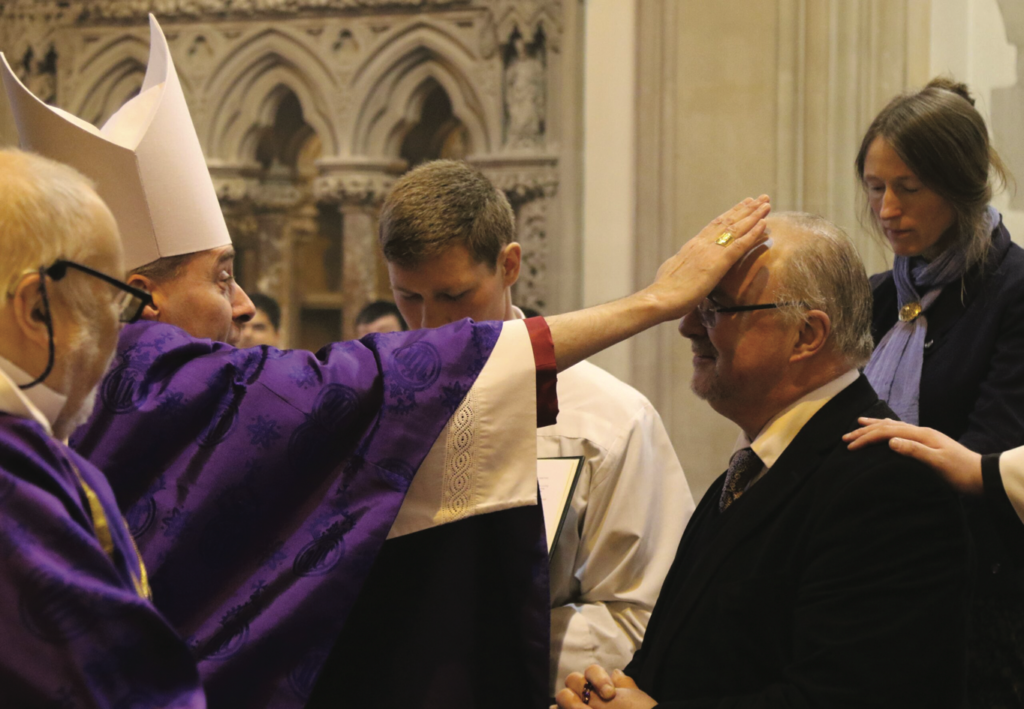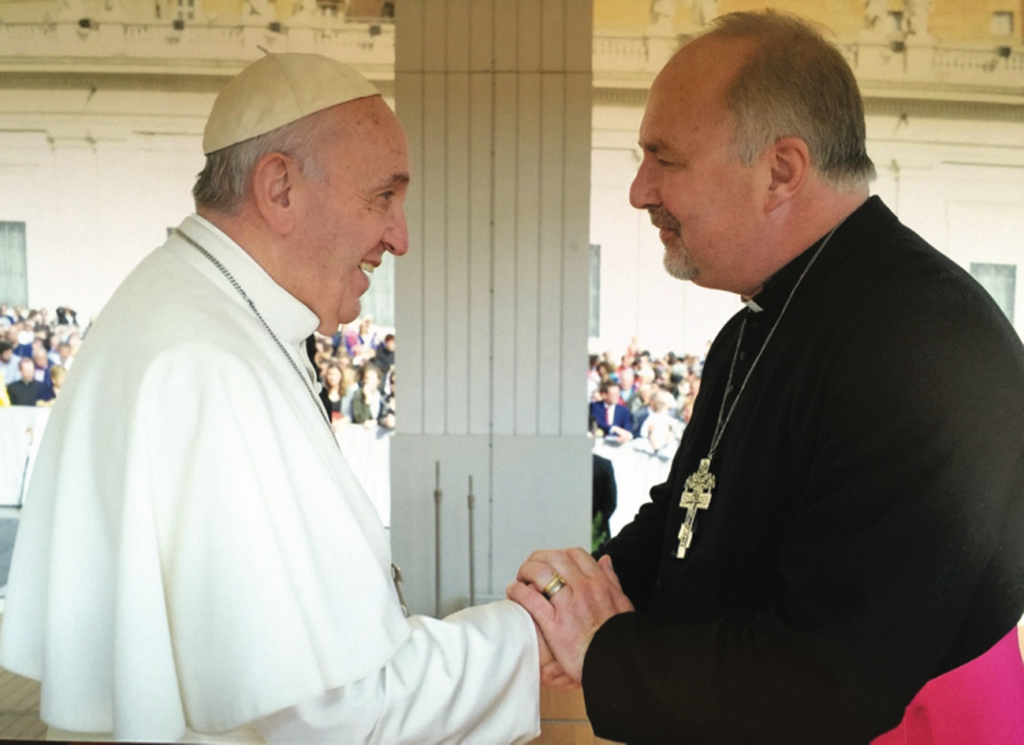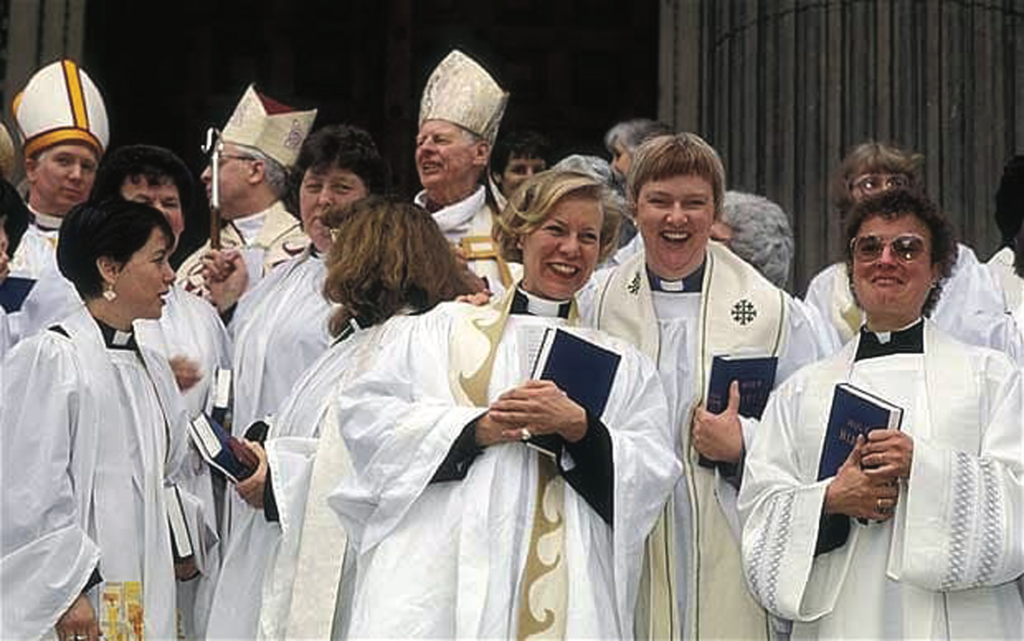A Former Anglican chaplain to the Queen of England talks about his entry into the Catholic Church — and the demise of Anglicanism
By Dr. Gavin Ashenden*

Gavin Ashenden, a former Anglican bishop, is blessed by Bishop Mark Davies of Shrewsbury, England, during Ashenden’s reception into the Catholic faith on December 19, 2019. Ashenden, a former chaplain to Queen Elizabeth II, said Prince Philip, who died April 9, 2021, was a man deeply interested in God. (CNS photo/Simon Caldwell)

Ashenden meeting with Pope Francis
*Dr. Gavin Ashenden is a former Anglican Archbishop and Honorary Chaplain to Queen Elizabeth of England, now a Catholic convert and layman. After a distinguished academic and clerical career, he was appointed Chaplain to the Queen in 2008; he resigned in 2017. In December 2019, Dr. Ashenden was received into the Catholic Church by the Bishop of Shrewsbury, England.
A moment sometimes comes when we suddenly see things entirely differently. Philosophers often call this “the moment of disclosure.” More popularly we talk about the moment that the penny drops.
One of those moments came for me when, after a vote in the Church of England’s General Synod, the progressives refused to make any space for those who wanted to practice the faith as it had been received, as my Bishop expostulated with despair as we left the assembly: “That,” he said, “is the end of the 500-year ecumenical experiment that was Anglicanism.” I thought he was perhaps a bit overwrought, but as I thought it through I began to realise the force of his observation. What he meant was that in the civil war between puritans, Anglo-Catholics and progressives, the progressives had just landed a knockout blow that would reconfigure the Church forever.
The Church of England is a confusing entity. It looks like one Church, but it isn’t; it was a conceptual compromise from its inception. To put it simplest, the Church inherited Catholic buildings and ecclesial structures but dressed and prayed as Protestants. Over the years the pendulum of power swung backwards and forwards between Puritans and Sacramentalists, but in the 20th century, the Church began to buckle under the assault of secular culture, led first by Darwin, Durkheim, Marx and Freud, and secondly, it crumpled under the assault of 19th-century German theological revisionism. But it was the feminism of the second half of the 20th century that did more harm.
A state Church is particularly vulnerable to cultural change. If the society it serves begins to reject Christian values or culture, it is faced with a dreadful dilemma. Either it has to go along with the repudiation, sprinkling putative blessing on the sub- or anti-Christian direction in which society goes; or else it has to take a moral stand and call society to return to Christian values; in other words, to repent.
There have been moments when repentance was tried. Wesley called for it over personal sin and corporate disbelief in the 18th century; Wilberforce and the Clapham Sect, over slavery in the 19th century; Bishop George Bell, over the carpet-bombing of German cities and the slaughter of civilians in the 20th century. But the feminism of the second half of the 20th century brought not only women priests, but acted as a Trojan horse for a variety of secular utopian values: relativism, equality of outcome, the triumph of the subjective over the objective, the campaign to cleanse the womb of unwanted infants, repudiation of patriarchy and “toxic masculinity.”
Though attractive in secular terms, they all undermined aspects of the integrity of Divine Revelation.
And so began an increasing process of preferencing a spiritual agenda for fixing things on earth rather than carrying souls to heaven; the Gaia of ecological apocalypticism and the prioritising of anti-racism became greater priorities than personal repentance and the rebirth of the soul.
But the two connected but distinctive movements that set out to change the apostolic DNA of the Church of England were the ordinations of women to the priesthood and episcopate, and then the ratification of homosexual relationships and marriage. Both the ordination of women and the affirmation of gay identities and relationships were prominent secular goals. But neither the feminism that lay behind the first, nor the disordered sexual turmoil that lay behind the second, were consistent with Scripture or tradition. So either this was a new revelation that the Church and world had been waiting for… or it was something else.
Feminism began to express itself in an ever louder antipathy to masculinity. The war of the sexes became more aggressive. The promotion of greater sympathy for homosexuality turned into a strident and aggressive threat to silence voices that questioned its legitimacy.
Where was the Church of England in these culture wars? Like so many Protestant groups, it was heavily invested in the values of progress and personal, social and political self-improvement. Two old heresies reappeared to give a platform to this new thinking. Arianism emerged as feminists complimented Jesus on his restricted but worthy acceptance of women, but castigated him for being a man of his time, blind to the improvements that it took the 21st century to discover. This was not the Logos that stood on the threshold of time and space as the Pauline cosmic Christ, but a historical figure limited by his particular culture. And Pelagianism laid the foundation for an unrealisable ambition to improve the lot of people by a renewed political and social energy for removing injustice and inequality. As the Church shifted the weight of its energies from evangelism and the Bible to social justice and activism, the more traditional faithful at either end of the Puritan and Catholic spectrum began to leave.
It was a vote in General Synod, where both these constituencies asked to have their theological and spiritual integrities recognised and protected, that caused the colleague I mentioned earlier such dismay.
Evangelicals and Anglo-Catholics had begged their fellow Anglicans to respect their beliefs and not impose women priests and bishops on them. The liberal majority refused, and refused with a jubilant satisfaction.
As I left that particular Synod I had an experience which acted as an interpretative lens for so much of what was happening in the wider Church. I found myself waiting at a bus stop, where next to me there appeared a well-known feminist activist priest. (She was soon to become a bishop herself, and was distinctive for two things: a love and promotion of nudism, and her discreet lesbian housemate.) I said something about what a terrible and bruising time we had in Synod. “Well, you know why we did what we did, of course?” she almost spat back at me. “No, I don’t think I do,” I replied. “We took revenge on you all. We punished you for every slight and disrespect any of you have ever shown to a woman.”
I was astonished, both by her vehemence and by what she had said. Without stopping to argue about her assumption of widespread misogyny, I replied, “But you have invoked a spirit of revenge. That is a spirit that is deeply opposed to the Holy Spirit. Have you any idea of the havoc that the invocation of such a spirit will wreak in the Church?”

Women priests, now quite common in the Anglican Church
She looked at me blankly. We were talking two different languages, and living in two different worlds.
So yes, the 500-year ecumenical experiment that had been the Church of England had ended. The awkward and precarious balance between Puritans, Anglo-Catholics and the devotees of the zeitgeist, was over.
The power grab had been effective and the internecine struggle had ended with the purge of the Puritans and the Anglo-Catholics. The Puritans had provided a vigorous and evangelistic congregationalism to the Anglican mix; and the Sacramentalists had injected a degree of Catholic piety and spirituality, borrowed from the Mother Church — an inclination for holiness and the Eucharist. It was they who had brought both depth of prayer and the width of new blood by conversion. Stripped of both wings of the Church, what was left was a shallow, politicised and de-energised centre, incapable of either spiritual renewal, repentance or conversion.
The Puritans fled into the wider evangelical world, and the Anglo-Catholics took a grateful refuge in the Catholic Church’s Ordinariate of the Chair of St. Peter, erected for those faithful coming from Anglicanism. Over 10 percent of the Roman Catholic parish clergy are now ex-Anglicans.
Meanwhile, the victory for the progressives looks increasingly pyrrhic. The demographics look bad. Only 1.9% attend church. Between 2009 and 2019, baptisms, weddings and funerals fell by between 30-40%. And 33% of the Anglican faithful are over 70.
As conservative Anglicans mobilize across the world, the lack of anything equivalent to the Catholic Magisterium leaves them prey to schism and sectarian conflict. Those many of us who have turned to the Catholic Church have done so because the turbulence of our day has caused us to look at the claims of the Reformation afresh — and found them wanting. On re-examination, many of us re-read the Fathers of the first five centuries and found there not Luther, Calvin Zwingli or Erastian settlements, but instead the Catholic Church and the Magisterium. The promise of Jesus to Peter in Matthew 16:18, “You are Peter and upon this rock I will build my Church, and the gates of hell shall not prevail against it,” rings with a new and urgent resonance.







Facebook Comments